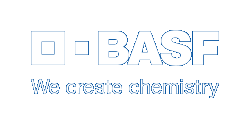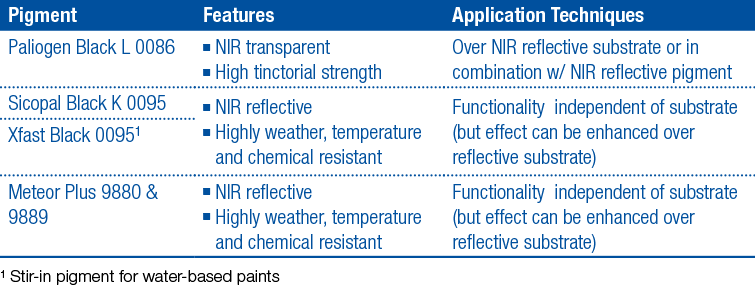Heat Reflective Cool Pigments for Paints and Coatings
Paliogen Black, Sicopal Black, Meteor Plus and Xfast Black
BASF’s “cool pigment” technologies with optimized spectral behaviors make it possible to formulate dark colors that reduce the heating effect in sunlight by reflecting the near infrared (NIR) portion of the spectrum. Paliogen NIR transparent pigments as well as Sicopal, Meteor Plus and Xfast NIR reflective pigments offer increased surface reflectivity and reduced surface heat build-up in coatings.
All dark surfaces that are exposed to sunlight heat up strongly, while light surfaces remain distinctly cooler. This is because dark surfaces absorb incident sunlight and convert it into heat, while light surfaces reflect more of the incoming energy.
|
NIR reflective aircraft coatings
Paliogen, Sicopal, Meteor Plus and Xfast pigments are dark pigments that offer dramatic heat-reducing benefits. In contrast to carbon black, the standard black pigment, which reflects less than 5% of the total incident solar energy, Paliogen Black and Sicopal Black pigments achieve total solar reflectance (TSR) values of 45% and 30%, respectively. As paints and coatings of many other color shades contain variable amounts of black pigments, heat build-up is greatly reduced by substituting the cool pigments for the carbon black. Consequently, the surface and interior of an aircraft coated with “cool paint” will remain much cooler during ground standby when exposed to high air temperatures and radiation loads.
BASF’s cool pigments can also be used in coatings of terminals, hangers and support buildings to also reduce interior temperatures and demand for air conditioning.
|
Usage guidelines
In many cases, both NIR transparent and reflecting pigments are used in the same formulation. Most black NIR reflecting pigments tend to be somewhat brownish in shade and need to be color corrected. Since carbon black cannot be used due to its propensity to absorb NIR energy, it is replaced by Paliogen Black pigments. The resultant color achieved by combining technologies resembles a true jet black with further improvements in heat management.
For optimum performance, NIR transparent and reflective pigments must be applied in the proper fashion to achieve maximum solar reflectance.
|
|
Software tool to calculate total solar reflectance of pigment compositions
BASF offers its customers a special service in the form of its “CoolSim” computer tool. This simulation program allows BASF experts to engineer the optimal pigment composition with the highest possible TSR for each desired color shade – an enormous advantage for users who then don’t have to conduct their own experiments.
|



